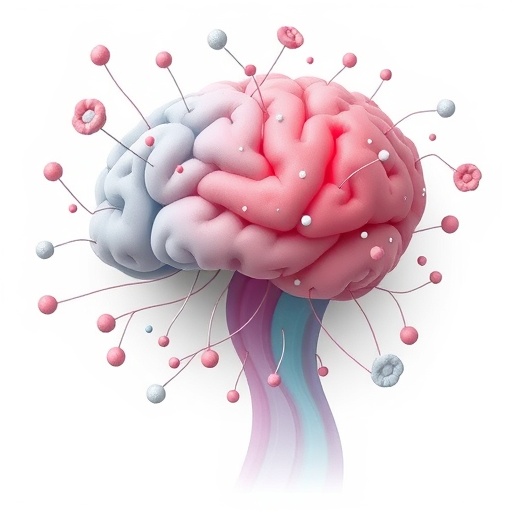In a groundbreaking systematic review published in BMC Psychology, researchers have unveiled significant insights into the intricate mechanisms of emotion regulation in individuals affected by Premenstrual Dysphoric Disorder (PMDD) and Premenstrual Syndrome (PMS). This comprehensive analysis sheds light on the neuropsychological and physiological underpinnings that differentiate the intense mood disturbances observed in PMDD from the more moderate symptoms commonly experienced in PMS. As mental health and hormonal fluctuations converge within this often misunderstood domain, the findings promise to reshape therapeutic strategies and elevate the discourse surrounding women’s mental health disorders.
At the core of this meta-analysis lies an exploration of how emotion regulation—a fundamental cognitive process allowing individuals to modulate their emotional states—operates under the distinct hormonal landscapes characterizing PMDD and PMS. Emotion regulation encompasses various mechanisms, including cognitive reappraisal, suppression, and attentional deployment, each contributing variably to an individual’s capacity to manage stressors. The researchers meticulously dissected data from numerous studies to elucidate the similarities and divergences in these regulatory processes between the two conditions.
PMDD, recognized as a severe form of premenstrual mood disorder, is characterized by debilitating emotional and physical symptoms that markedly impair daily functioning. Unlike PMS, which affects a broader segment of the population with less severe manifestations, PMDD sufferers endure profound mood lability, irritability, and depressive episodes during the luteal phase of the menstrual cycle. This review underscores the hypothesis that dysregulation in neurocircuitry, particularly in regions implicated in emotion processing such as the amygdala, prefrontal cortex, and hippocampus, plays a pivotal role in PMDD.
One of the key technical revelations involves the differential activation patterns within the limbic system during premenstrual phases. The compiled functional imaging studies point toward heightened amygdala sensitivity in PMDD patients when exposed to emotionally salient stimuli, coupled with diminished top-down inhibition from the prefrontal cortex. This imbalance ostensibly leads to an exaggerated emotional response and impaired ability to implement adaptive emotion regulation strategies. Conversely, individuals with PMS exhibit subtler alterations, suggesting a less profound neurobiological disruption.
Moreover, the hormonal milieu, particularly fluctuations in progesterone and its metabolite allopregnanolone, emerges as a critical modulator of GABAergic neurotransmission, which influences anxiety and mood regulation. The review highlights evidence suggesting that in PMDD, altered sensitivity to these neurosteroids leads to dysfunctional inhibitory signaling, exacerbating emotional dysregulation. This neurochemical perspective bridges endocrine dynamics with observed behavioral symptoms, offering a mechanistic explanation for the cyclical nature of mood disturbances.
Interestingly, this systematic review delves into cognitive aspects such as impairment in executive functioning and working memory that often accompany PMDD. Deficits in these domains may hinder effective emotion regulation by compromising an individual’s ability to reframe negative thoughts or suppress inappropriate emotional responses. Experimental paradigms included in the review consistently demonstrate that PMDD subjects perform worse on tasks requiring cognitive control during symptomatic phases, reinforcing the interplay between cognitive dysfunction and affective symptoms.
Another notable dimension of the analysis concerns the impact of emotion regulation difficulties on interpersonal relationships and quality of life. The authors articulate how PMDD’s severe mood symptoms precipitate social withdrawal, increased conflict, and distress, creating a vicious cycle that perpetuates emotional instability. The severity of such psychosocial impairment far exceeds that observed in PMS, emphasizing the necessity for distinct clinical attention and intervention frameworks for PMDD.
Therapeutically, the review suggests promising directions that transcend conventional pharmacological treatments such as selective serotonin reuptake inhibitors (SSRIs). Psychotherapeutic approaches oriented toward enhancing emotion regulation skills—like cognitive behavioral therapy (CBT) and mindfulness-based interventions—demonstrate preliminary efficacy. Tailoring these modalities to address the unique hormonal and neurobiological context of PMDD could optimize outcomes and reduce relapse rates.
Importantly, the review identifies methodological inconsistencies in existing literature, such as variability in diagnostic criteria, sample sizes, and emotion regulation assessment tools, which impede conclusive interpretations. Standardizing research protocols and integrating multi-modal assessments, including neuroimaging, hormonal profiling, and ecological momentary assessment (EMA), are proposed to enrich future investigations.
The authors also advocate for expanded research into genetic and epigenetic contributors underlying individual differences in hormone sensitivity and emotion regulation capacity. Such explorations could illuminate personalized vulnerability pathways and aid in the development of biomarker-driven diagnostic and treatment strategies, heralding a precision medicine approach to premenstrual disorders.
Environmental and psychosocial stressors are addressed as modulators that interact with biological predispositions to exacerbate emotion regulation challenges. The review underscores the complexity of disentangling these factors, noting that life stress can amplify hormonal impacts, thereby intensifying symptom severity. Recognizing this interplay could improve holistic management by integrating social support and stress reduction techniques.
The synthesis concludes by emphasizing the critical importance of elevating awareness about PMDD as a distinct clinical entity. Given its profound implications for affected women’s mental health and productivity, enhanced screening and early intervention are paramount. This review serves as a clarion call for both clinicians and researchers to prioritize emotion regulation mechanisms as key targets for innovation in diagnosis and treatment.
Finally, the systematic review offers a transformative perspective on the pathophysiology of premenstrual mood disorders. By framing emotion regulation difficulties in the context of neuroendocrine fluctuations and cognitive deficits, it paves the way for multidisciplinary research that bridges gaps between psychiatry, endocrinology, and neuroscience. The insights gained hold promise not only for therapeutic advancements but also for destigmatizing experiences that have long been minimized or mischaracterized.
As this influential study circulates through the scientific community and public discourse, it beckons a new era of understanding and empathy toward women’s mental health conditions linked with menstrual cycles. By elucidating the nuanced biological and psychological undercurrents of PMDD and PMS, this review fosters hope for more effective interventions that honor the complexity of these disorders.
Subject of Research: Emotion regulation mechanisms in Premenstrual Dysphoric Disorder (PMDD) and Premenstrual Syndrome (PMS)
Article Title: Emotion regulation in Premenstrual Dysphoric Disorder and Premenstrual Syndrome: a systematic review
Article References:
Lambert, E., Hunter, M., Cocker, H. et al. Emotion regulation in Premenstrual Dysphoric Disorder and Premenstrual Syndrome: a systematic review. BMC Psychol 13, 1289 (2025). https://doi.org/10.1186/s40359-025-03587-y
Image Credits: AI Generated
DOI: https://doi.org/10.1186/s40359-025-03587-y




